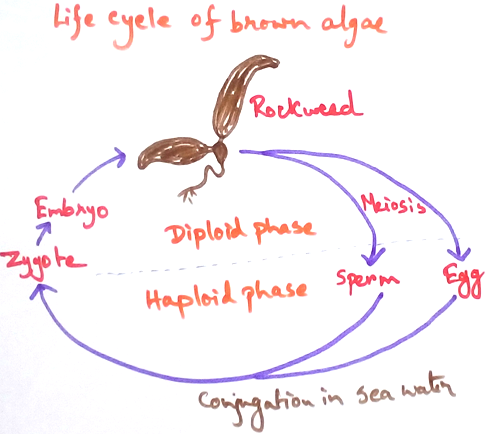Phaeophyceae
Phaeophyceae are brown colour algae that live mostly in cooler seas.
Characteristics of phaeophyceae are following
(i) Mostly marine, only a few are fresh water.
(ii) All species are multicellular; the plants may exhibit complex morphology with highly differentiated tissue.
(iii) Flagella laterally inserted, heterokont with one anterior longer tinsel and another posterior shorter, whiplash, flagellate cells are always reproductive, no free living flagellate.
(iv) Flagellate cells have typical heterokont photoreceptors at the base of smooth flagellum and have adjoining eyespot inside the cells within the chloroplasts.
(v) Transition region of flagellum is lack of transition helix.
(vi) Chloroplasts are may be discoid.
(vii) Chloroplasts are having two membranes of chloroplast endoplasmic reticulum, thylakoid grouped into stacks of three, girdle lamella present.
(viii) Photosynthetic pigments are chlorophyll a, chlorophyll c1, chlorophyll c2, fucoxanthine.
(ix) Additional xanthophylls: violaxanthin, antheraxthine, neo xanthine, diadioxanthin, diatoxanthine, beta carotenes may be present.
(x) Mitosis are of semi closed.
(xi) Cell wall composed of felt like network of cellulose microfibrils, calcium alginate, amorphous fucoxanthine and mucilaginous alginate causes stiffening of the cell wall.
(xii) Sexual reproduction iso, aniso, to oogamous.
(xiii) Gametes are produced in plurilocular gametangia.
(xiv)Meiospores are produced in until ocular sporangia.
(xv) Life cycle diplobiontic or haplobiontic diploid type.
(xvi) In case of later meiosis is gametic.
(xvii) Sex hormone in Phaeophyceae - sex hormone in phaeophyceae are pheromones like diffusible substances (sirenine). This substances cause explosive discharge of male gametes from antheridia. Sex hormones of phaeophyceae are unsaturated hydrocarbons which are highly volatile in nature and hydrophobic by its nature. So, they help female gametes to attract male gametes towards female gametes. Examples of some sex hormones are – lamoxirene from Laminaria etc.
Laminaria, Sargassum are edible algae.
Phaeophyceae can be divided into different order. They are following-
1. Ectocarpales
2. Sphacelariales
3. Cutleriales
4. Laminariales
5. Fucales
6. Dictyotales
Questions and answers on Phaeophyceae:
1. What is photosynthetic reserve in phaeophyceae?
Laminarin.
2. How are brown algae related to ozone hole?
Like man made halogenated compounds, CFC (chlorophyll fluro carbon), brown algae are known to release large quantities of volatile brominated methanes into the environment. It is suspected to be responsible for ozone destruction in the atmosphere above the Arctic as the annual global input of the algal organobromides has been estimated at ca 10000 tonnes per year. Arctic is dominated by gigantic seaweed.
3. What do you mean by sirenine?
Sex hormones of phaeophyceae are called sirenine.
4. Name a member of phaeophyceae where encrustation of calcium carbonate is observed.
Padina.
5. What do you know about kelps?
Members of Laminariales are called kelps. The term is also applied to burn ash of Laminariales. Kelps are characterised by large sporophytic thallus differentiated into holdfasts, stipe, blade regions with an intercalary meristem located at the junction of the stipe and blade.
6. Where do you find phase change in Phaeophyceae?
Phase change is an unusual phenomenon noticed in certain Phaeophyceae where two morphologically different thallus types occur in the same number not always associated with sexual reproduction or change in chromosomal level. E.g. the same taxon known under two generic names Feldmannia and Acinetospora actually represents different ecological manifestations under different climatic conditions. Acinetospora forms in cold season where as Feldmannia occurs in warm season.
From Phaeophyceae to HOME PAGE
Recent Articles
-
What Is Plasma? | Blood Plasma | Proteins | Nutrients | Cholesterol
Nov 07, 25 10:29 AM
Blood is a mobile fluid which is a connective tissue and is derived from the mesoderm like cell any other connective tissue. Colour of blood is reddish and that flows inside the blood vessels by means… -
Disorders of Respiratory System | Tuberculosis | Pleurisy | Emphysema
Oct 28, 25 11:39 PM
Tuberculosis is very common disease and is caused by a type of bacteria called Mycobacterium tuberculosis. This disease causes different trouble in the respiration and infection of several parts of th… -
Regulation of Respiration | Respiratory Centres | Inspiratory Area |
Oct 14, 25 12:13 AM
Respiratory Centre is the area that controls the rate of respiration and it is observed to be located in medulla oblongata and pons. Respiratory Centre has the following will dispersed components like… -
Explain Transport of Gases | External Respiration | Tissue Respiration
Oct 09, 25 11:35 PM
In humans gaseous exchange is completed in the following ways the steps are - External Respiration or Breathing - Breathing in false taking in of Oxygen and giving out of carbon dioxide in the body. M… -
Kind and Number of Teeth | Location of Teeth in Mouth | Care of Teeth
Sep 11, 25 12:52 AM
Kind and Number of Teeth






New! Comments
Have your say about what you just read! Leave me a comment in the box below.